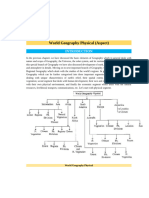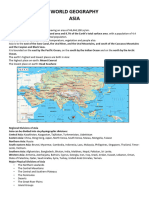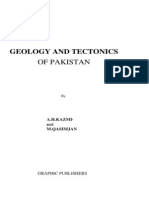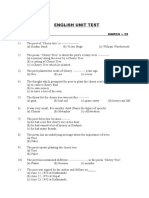0 ratings0% found this document useful (0 votes)
57 viewsLesson 1 Asian Studies
Lesson 1 Asian Studies
Uploaded by
Rei MelendezThe document provides an overview of the geography, climate, and culture of Asia. It notes that Asia is the largest continent and has extreme physical diversity. It describes some of Asia's key physical features, including its highest and lowest elevations, largest countries and bodies of water. The document then discusses Asia's major mountain ranges and river systems. It outlines the different climatic zones in Asia and how they affect vegetation and populations. In addition, it notes that Asia is the origin point of several major world religions and describes its main linguistic groups.
Copyright:
© All Rights Reserved
Available Formats
Download as PDF, TXT or read online from Scribd
Lesson 1 Asian Studies
Lesson 1 Asian Studies
Uploaded by
Rei Melendez0 ratings0% found this document useful (0 votes)
57 views60 pagesThe document provides an overview of the geography, climate, and culture of Asia. It notes that Asia is the largest continent and has extreme physical diversity. It describes some of Asia's key physical features, including its highest and lowest elevations, largest countries and bodies of water. The document then discusses Asia's major mountain ranges and river systems. It outlines the different climatic zones in Asia and how they affect vegetation and populations. In addition, it notes that Asia is the origin point of several major world religions and describes its main linguistic groups.
Original Title
Lesson-1-Asian-Studies
Copyright
© © All Rights Reserved
Available Formats
PDF, TXT or read online from Scribd
Share this document
Did you find this document useful?
Is this content inappropriate?
The document provides an overview of the geography, climate, and culture of Asia. It notes that Asia is the largest continent and has extreme physical diversity. It describes some of Asia's key physical features, including its highest and lowest elevations, largest countries and bodies of water. The document then discusses Asia's major mountain ranges and river systems. It outlines the different climatic zones in Asia and how they affect vegetation and populations. In addition, it notes that Asia is the origin point of several major world religions and describes its main linguistic groups.
Copyright:
© All Rights Reserved
Available Formats
Download as PDF, TXT or read online from Scribd
Download as pdf or txt
0 ratings0% found this document useful (0 votes)
57 views60 pagesLesson 1 Asian Studies
Lesson 1 Asian Studies
Uploaded by
Rei MelendezThe document provides an overview of the geography, climate, and culture of Asia. It notes that Asia is the largest continent and has extreme physical diversity. It describes some of Asia's key physical features, including its highest and lowest elevations, largest countries and bodies of water. The document then discusses Asia's major mountain ranges and river systems. It outlines the different climatic zones in Asia and how they affect vegetation and populations. In addition, it notes that Asia is the origin point of several major world religions and describes its main linguistic groups.
Copyright:
© All Rights Reserved
Available Formats
Download as PDF, TXT or read online from Scribd
Download as pdf or txt
You are on page 1of 60
LESSON 1:
THE ASIAN CONTINENT
THE CONTINENT OF ASIA
- largest continent in terms of size and
population
- has extreme physical diversity
- a paranoma of nations
- Pacific Ocean in the east, Europe via the Ural
Mountains and Caspian Sea in the west, Africa
in the southwest and Red Sea in the south
3
BASIC FACTS ABOUT ASIA
- Mt. Everest is the highest elevation
- Dead Sea is the lowest elevation
- China is the largest country
- Maldives is the smallest country
- Caspian Sea is the largest lake
- Lake Baikal is the deepest lake
- Yangtze River is the largest river
- Angkor Wat is the largest temple
Altai Mountain Ranges
It forms a lofty range that
runs northwest across the
borders of Western Mongolia
and Kazakhstan and is one of
the oldest mountains in Asia.
They contain much deposits
of lead.
Elburz Mountain Ranges
They stand along Iran’s
northern border and form a
spectacular wall between the
Caspian Sea coast region and
the interior plateau. Iran’s
highest peak, Mt. Damavand
is found in these ranges.
Himalaya Mountain Ranges
These are the highest
mountain system in the world.
The term “Himalaya” comes
from the Sanskrit language
which means, “The House of
Snow” or the “Snowy
Range”.
Himalaya Mountain Ranges
MT. EVEREST MT. KAILAS
Goddess Mother of the World The Mountain of Precious Snow
Hindu Kush
It is a chain of
mountains in Central
Asia. It is called
Caucasus by the
historians of Alexander
the Great.
Pamirs (Roof of the World)
It is a huge region where
the Himalayas, Hindu
Kush, Kunlun and Tien
Shan mountains meet and
one of the highest
plateaus of the world.
Karakoram Mountain
It is a range of
mountains in Kashmir in
Northwestern India,
which also extends to
Tibet and China. It
extends southwestward
from the Pamir Knot.
Kunlun Mountains
These mountains extend
from the Pamir
Highland in Central
Asia to Central China.
Its highest peak, Ulugh
Muztagh is located in
China.
Stanovoy Mountains
These are mountain
ranges in Siberia
extending from the
northern end of Lake
Baikal and northeast to
the Sea of Okhosk.
Tien Shan Mountains
These are mountain system
in Central Asia running
northeast from the Pamirs.
Tien Shan means
“Heavenly Mountains” and
is the highest mountain
system near Tibet.
Yablonovy Mountains
These lie east of
Lake Baikal in
Siberia. The range
extends northeast
from Mongolia until
it joins the Stanovoy
Mountains.
Mt. Sokhondo
It is the
highest
peak in
Central
Asia.
Zagros Mountains
These extend
south and east
from the borders
of Turkey and
Central Asia to
the Persian Gulf.
Amur River
It is found in Eastern
Siberia and formed by the
joining of the Argun and
Silka Rivers. Among the
Chinese, the Amur is
“Heilong Jiang” or
“Black Dragon River”.
Brahmaputra River
It is one of the most
important waterways of
South Asia. It rises on the
northern slopes of the
Himalayas in Tibet and
flowing through Northeast
India and Bangladesh.
Euphrates River
It is the longest river in
Southwest Asia and
rises at a mountainous
area of Eastern Turkey
and flows southeast
through the country into
Syria.
Ganges River
It is the greatest waterway
in India and one of the
largest in the world. It is
very important among the
Hindus because it plays a
very crucial part in their
religious rituals.
Huang Ho River
It is the China’s second
largest river and is called
“China’s Sorrow” because
of the many floods which
brought death and hunger
to the people living along
its banks.
Indus River
It is the great river of
Pakistan and rises in
Tibet, north of the
Himalayas and travels
west and southwest and
empties its water into
the Arabian Sea.
Irrawady River
It is the chief river of
Burma and rises in high
region in northern
Burma flowing through
a densely populated
area and enters the Bay
of Bengal.
Lena River
It is the chief waterway of
the eastern part of Siberia
and rises on the slope of
Baikal Mountains and
flows northwest. It empties
into the Arctic Ocean
through the Lalptev Sea.
Mekong River
It is the largest stream
in the Indo-Chinese
Peninsula and flows
southward from Eastern
Tibet and forms part of
the boundary between
Thailand and Laos.
Ob River
It is one of the chief
rivers of North Asia and
rises in the Altai
Mountain of Western
Siberia and flows
northwestward.
Salween River
It is an important river in
Myanmar and rises in
Eastern Tibet and flows
through Eastern Burma to
the Bay of Bengal and
drains Eastern Burma
and Western Thailand.
Tigris River
It is a major river of
Southwestern Asia and
rises from the mountain
over the terrain of
Eastern Turkey and
follows the course of the
Euphrates River.
Xi Jiang River
It is the most
important stream of
Southern China and
rises on the border of
Yunan and Guinzhou
provinces and flows
southeast.
Yangtze River
It drains in Siberia
and travels from its
origin in the Sayan
Mountains of
Southern Siberia to
its mouth on the
Arctic Coast.
Gobi Desert
It is the largest desert
in Asia and is a
windswept, nearly
treeless desert that
stretches part of
Southern Mongolia and
of Northern China.
Kara Kum
It is a large desert that
comprises most of
Turkmenistan and is a
source of mineral
resources such as
natural gas, petroleum,
and sulfur.
Kyzyl Kum
It is a desert that lies in
Southern Kazakhstan and
Northern Uzbekhistan. It
covers about 88,000 square
miles between Syr Darya
and Amu Darya rivers, and
southeast of the Aral Sea.
Takla-Makan Desert
It lies in
Northwestern China
between the Tien Shan
and Kunlun
mountains. It s small
hills and shifting sand
dunes cover in the
Xingjiang region.
Arctic Asia
It has two icy zones extending
laterally across norther part
of Asia-the treeless tundra
along the Arctic coast, rich in
oil and gas, and to the south,
the once trackless and endless
taiga of forest
Monsoon Asia
The skeletal
terrain system
of great ranges
radiating out
from the
“Pamir Knot”
and Tibet.
Arid Asia
It is a broad band of desert
and dry areas extending from
Jordan and Saudi Arabia
through much of Iraq, Iran,
Afghanistan, Pakistan, and
Central or High Asia to
Mongolia.
Subtropical and Moonsoon Asia
It is generally
fertile and
heavily
populated
regions of South,
Southeast, and
East Asia.
Those climatic zones are divided into seven types
to facilitate location.
I. Tundra
II. Temperate forest (mostly coniferous taiga on the
mainland)
III. Grassland, steppe
IV. Desert and arid regions
V. High plateau steppe or ice desert
VI. Subtropical rain forest
VII. Tropical monsoon rain forest
Climatic belts extend across Asia from east to
west. In all these zones, the people and their
occupations vary widely. These Asian climatic zones
also affect outlying regions such as the cold air mass
above icy Tibet and the frozen tundra seasonally flows
down Asia’s eastern coasts and island chains to
displace the warm air over the equator. The continent
also finds the successive typhoons which aggressively
circle west and north from the Caroline Islands
through the Philippines to Japan.
Demographically speaking, Asia likewise
projects an irregular distribution of people from the
most crowded to the scantiest area. Such unevenness
is brought about by the existence of alluvial soil and
irrigation water due to the presence of river systems
or sufficient rain, added with warm sunlight that
could truly support huge population of farmers.
People naturally cluster around these favored lands
where water is available for industry to flourish.
The total ways of life of a
community reveals two aspects:
(1) society as the organized
aspect, and
(2) culture as the behavioral
aspect.
Asia is the continent where the world’s major
religions originated:
- Christianity
- Judaism
- Islam
- Buddhism
- Hinduism
- Zoroastrianism
- Shintoism and others
The five geographical regions of Asia
correlate closely with the political boundaries of the
nations.
A. Southwest Asia (ethnic)
Arab Bloc: Syria, Lebanon, Jordan, Saudi
Arabia, Yemen, Oman, United Arab Emirates, Qatar,
Bahrain, Kuwait, Iraq
Non-Arab Bloc: Turkey, Cyprus, Israel, Iran,
Afghanistan
B. South Asia (religious)
Hindu Bloc: India, Nepal
Non-Hindu Bloc: Pakistan, Bangladesh,
Bhutan, Sri Lanka, Maldives
C. Central Asia/Inner Asia including North Asia
(political)
Mongolia, Central Asian Republics:
Kazakhstan, Tajikistan, Uzbekistan, Turkmenistan,
Kyryzstan
D. East Asia (ideological)
Socialist Bloc: China, North Korea
Democratic Bloc: Japan, South Korea, Taiwan
E. Southeast Asia (geographical)
Mainland Southeast Asia: Myanmar,
Thailand, Vietnam, Cambodia, Malaysia, Laos
Insular Southeast Asia: Indonesia,
Philippines, Brunei Darussalam, East Timor,
Singapore
Indo-European
(Central and South Asia)
Sino-Tibetan Austronesian
(East and Southeast Asia) (insular Southeast Asia)
Altaic Dravidian
(mainly in Central Asia) (confined in South Asia)
You might also like
- NIOS History Notes (English)Document376 pagesNIOS History Notes (English)Suraj Verma100% (1)
- Chapter 1Document21 pagesChapter 1Black HornetNo ratings yet
- Asia 1Document5 pagesAsia 1bhuvirathi10No ratings yet
- ecn 004 new - CopyDocument96 pagesecn 004 new - Copymacbase publishNo ratings yet
- Chapter 1 - The Asian ContinentDocument40 pagesChapter 1 - The Asian ContinentStephanie HwangNo ratings yet
- ecn 004 newDocument85 pagesecn 004 newmacbase publishNo ratings yet
- GEOGRAPHICAL FEATURESDocument43 pagesGEOGRAPHICAL FEATURESJessa Mae SerranoNo ratings yet
- PDFs World Geography - AsiaDocument9 pagesPDFs World Geography - Asiabhadanaharsh47No ratings yet
- AsiaDocument3 pagesAsiabhuvirathi10No ratings yet
- World Geography For UPSC IAS NotesDocument23 pagesWorld Geography For UPSC IAS NotesJayaprakash0% (1)
- AsiaDocument13 pagesAsiaJerlyn Mae Quiliope-LumambaNo ratings yet
- Continent of AsiaDocument7 pagesContinent of AsiaBasco Martin JrNo ratings yet
- Spatial and Social Relations in AsiaDocument12 pagesSpatial and Social Relations in AsiaScribdTranslationsNo ratings yet
- Private Files Geography of AsiaDocument37 pagesPrivate Files Geography of AsiaDan GregoriousNo ratings yet
- AsiaDocument9 pagesAsiamarivic b.indopiaNo ratings yet
- Video: Alex Parra Peralta, Brayan Lozano CuevasDocument8 pagesVideo: Alex Parra Peralta, Brayan Lozano CuevasVicente Pérez NavarroNo ratings yet
- Module 1Document13 pagesModule 1Jercy Ann TorresNo ratings yet
- The Giant BOOK 1000 Pages On The Mysteries of NUSUNTARADocument206 pagesThe Giant BOOK 1000 Pages On The Mysteries of NUSUNTARAUday DokrasNo ratings yet
- 11 Physical Geography of AsiaDocument26 pages11 Physical Geography of Asiahashirama0801No ratings yet
- World Geography KGS UPSCDocument62 pagesWorld Geography KGS UPSCourhabitudeNo ratings yet
- Prelim AttachmentsDocument10 pagesPrelim AttachmentsShmaira Ghulam RejanoNo ratings yet
- World GeographyDocument366 pagesWorld Geographyanju s gouda k IrabageraNo ratings yet
- Asia Location Extent Political and Physical FeaturesDocument2 pagesAsia Location Extent Political and Physical FeaturesjfgNo ratings yet
- Chapter 2 AsiaDocument42 pagesChapter 2 Asiapamela alviola100% (1)
- Diverse Continent Asia Homogeneous Diversity Encompasses: Asia, The World's Largest and MostDocument30 pagesDiverse Continent Asia Homogeneous Diversity Encompasses: Asia, The World's Largest and MostRose Ann RayoNo ratings yet
- Lecture NotesDocument14 pagesLecture Notesmercadokim33No ratings yet
- Geography of Asia by Prof M HaroonDocument57 pagesGeography of Asia by Prof M HaroonHaroon khanNo ratings yet
- Eurasian Steppe - WikipediaDocument3 pagesEurasian Steppe - WikipediaGowtham NemaniNo ratings yet
- Samplenotes Gs PrelimsDocument148 pagesSamplenotes Gs PrelimsGSNo ratings yet
- Geography Ch-2 Major Physiographic Divisions: HimalayasDocument32 pagesGeography Ch-2 Major Physiographic Divisions: Himalayaskunal anandNo ratings yet
- Asia Class 9Document12 pagesAsia Class 9Sunidhi DasNo ratings yet
- Physiographic Division of IndiaDocument30 pagesPhysiographic Division of IndiaGurdarshan Singh Singh100% (1)
- MODULE No. 1 ASIAN STUDIESDocument3 pagesMODULE No. 1 ASIAN STUDIESEdnalyn BulandosNo ratings yet
- Regions of AsiaDocument42 pagesRegions of AsiaEdgardo Avila de DiosNo ratings yet
- CH 2 ASIA CDocument21 pagesCH 2 ASIA CXain RanaNo ratings yet
- Asia Physical Geography PWDocument25 pagesAsia Physical Geography PWDan GregoriousNo ratings yet
- Continents: This Section Is Taken From The BookDocument12 pagesContinents: This Section Is Taken From The BookHarshit PandeyNo ratings yet
- Central Asia Is The Core Region of The Asian Continent and Stretches From The Caspian Sea in The WestDocument6 pagesCentral Asia Is The Core Region of The Asian Continent and Stretches From The Caspian Sea in The WestOlivia GuptaNo ratings yet
- AsiaDocument9 pagesAsiaraziakhatun542No ratings yet
- Grade 7 Asia REVIEWERDocument142 pagesGrade 7 Asia REVIEWERAlexaNo ratings yet
- Araling Panlipunan Ash ReviewerDocument2 pagesAraling Panlipunan Ash ReviewerMAUREEN MEDESNo ratings yet
- Physical Geography of AsiaDocument8 pagesPhysical Geography of AsiaParkerman101No ratings yet
- gRADE 7 - GeographyDocument21 pagesgRADE 7 - Geographyjose.jose3xNo ratings yet
- World Geography Asia NotesDocument12 pagesWorld Geography Asia NotesYogaj DarshanNo ratings yet
- Notes GeographyDocument7 pagesNotes Geographyshanumisra79No ratings yet
- Assignment in APDocument9 pagesAssignment in APRey MarkNo ratings yet
- Physical Divisions in AsiaDocument4 pagesPhysical Divisions in AsiaTech 4 TechnologyNo ratings yet
- Exam Reviewer Sse 116 Profed7Document17 pagesExam Reviewer Sse 116 Profed7padiernosaceNo ratings yet
- Asian CivilizationDocument72 pagesAsian Civilizationmaria erika100% (6)
- Physical Features of IndiaDocument5 pagesPhysical Features of IndiaTapas BanerjeeNo ratings yet
- Asia: Physical Geography: Biology, Earth Science, Geology, Geography, Human Geography, Physical GeographyDocument10 pagesAsia: Physical Geography: Biology, Earth Science, Geology, Geography, Human Geography, Physical GeographyAilene Nace GapoyNo ratings yet
- SST 9th Geography Lesson 2Document4 pagesSST 9th Geography Lesson 2Chaitanya SeriouskalhapureNo ratings yet
- Physical Environment of AsiaDocument14 pagesPhysical Environment of AsiasollegueNo ratings yet
- Physical Features of IndiaDocument3 pagesPhysical Features of Indiaseemas4535No ratings yet
- 8geography CH 62023 1Document9 pages8geography CH 62023 1dakshonly.23No ratings yet
- A.P. ReviewerDocument9 pagesA.P. ReviewerAnne Besin0% (1)
- By: Gorka Alda Josu Echevarria Ruben Vergara Adrian Martinez Adrian Alvarez Social Science 1ºa EsoDocument14 pagesBy: Gorka Alda Josu Echevarria Ruben Vergara Adrian Martinez Adrian Alvarez Social Science 1ºa Esoecheva49No ratings yet
- Physical Featues of India - 9 CBSEDocument3 pagesPhysical Featues of India - 9 CBSEEshan AttarNo ratings yet
- 11 - Std'09 - Social Science - Geography - Contemporary India Part-IDocument25 pages11 - Std'09 - Social Science - Geography - Contemporary India Part-ImoneythindNo ratings yet
- Disha Instant GeographyDocument31 pagesDisha Instant GeographySuhailHaqueNo ratings yet
- NITI HimalyaDocument58 pagesNITI HimalyaDevesh Pratap SinghNo ratings yet
- SSC Graduate 2022 PyqDocument36 pagesSSC Graduate 2022 Pyqroshniawasthi1597No ratings yet
- Chapter 2 PP Solution Physical Features of IndiaDocument2 pagesChapter 2 PP Solution Physical Features of IndiaPaban RajNo ratings yet
- Elv 29Document30 pagesElv 29Catalin VelcsovNo ratings yet
- Ferns and Fern Allies of District Shopian, Kashmir Valley, IndiaDocument17 pagesFerns and Fern Allies of District Shopian, Kashmir Valley, IndiaEdo DannyNo ratings yet
- Belur Geography Location&PhysiographyDocument4 pagesBelur Geography Location&Physiographysourodipbisai1234No ratings yet
- History 11th BookDocument336 pagesHistory 11th Bookadhishreesinghal24No ratings yet
- Influence of Geography: Amrita Gautam Teaching Assistant Kathmandu School of LawDocument29 pagesInfluence of Geography: Amrita Gautam Teaching Assistant Kathmandu School of LawSajina BajgainNo ratings yet
- Physical Features of IndiaDocument14 pagesPhysical Features of Indiacome2sandhyaNo ratings yet
- Vegetation Types of Nepal Book WebDocument90 pagesVegetation Types of Nepal Book WebAvi HamalNo ratings yet
- HimalayasDocument1 pageHimalayasCharles CorneliusNo ratings yet
- India - Climate, Natural Vegetation and WildlifeDocument14 pagesIndia - Climate, Natural Vegetation and Wildliferiddhiagarwal2629No ratings yet
- Indian Geography NotesDocument89 pagesIndian Geography NotesShubham100% (7)
- Natural Vegetation and Wild LifeDocument76 pagesNatural Vegetation and Wild LifeGagan SinghNo ratings yet
- 10 Best Treks To Do in Nepal For 2022/2023Document10 pages10 Best Treks To Do in Nepal For 2022/2023Nabin PoudelNo ratings yet
- Kazmi and JanDocument528 pagesKazmi and JanShahbaz Gul100% (33)
- GK & CA & Essays by Tahir HabibDocument150 pagesGK & CA & Essays by Tahir HabibTahir HabibNo ratings yet
- A Project ReportDocument99 pagesA Project ReportKhaja PashaNo ratings yet
- Class 9 Social Science Geography Notes For Session 2023 24 ChapterDocument30 pagesClass 9 Social Science Geography Notes For Session 2023 24 ChapterSuhani Dureja100% (1)
- Our Country India: I.Multiple Choice QuestionsDocument6 pagesOur Country India: I.Multiple Choice QuestionsGopa Bhattacharyya100% (1)
- Geography Part 3Document154 pagesGeography Part 3vedic competitivestudyNo ratings yet
- English Unit Test Paper.Document2 pagesEnglish Unit Test Paper.siddharth rambhiaNo ratings yet
- Geography PPPDocument161 pagesGeography PPPMUHAMAD HUSSAINjunaidNo ratings yet
- 1 Mango-Birds: Class-4 English Worksheet-4Document16 pages1 Mango-Birds: Class-4 English Worksheet-4Kajal GuptaNo ratings yet
- INDIADocument16 pagesINDIANikhila NaiduNo ratings yet
- Geography: Landscape and ClimateDocument5 pagesGeography: Landscape and Climateankush birlaNo ratings yet
- West Bengal Mountains and PeaksDocument12 pagesWest Bengal Mountains and PeaksSelvin RajaNo ratings yet
- Jyoti SinghDocument6 pagesJyoti SinghsinuNo ratings yet

























































































